fuel pressure PORSCHE PANAMERA 2010 1.G Information Manual
[x] Cancel search | Manufacturer: PORSCHE, Model Year: 2010, Model line: PANAMERA, Model: PORSCHE PANAMERA 2010 1.GPages: 80, PDF Size: 6.26 MB
Page 6 of 80
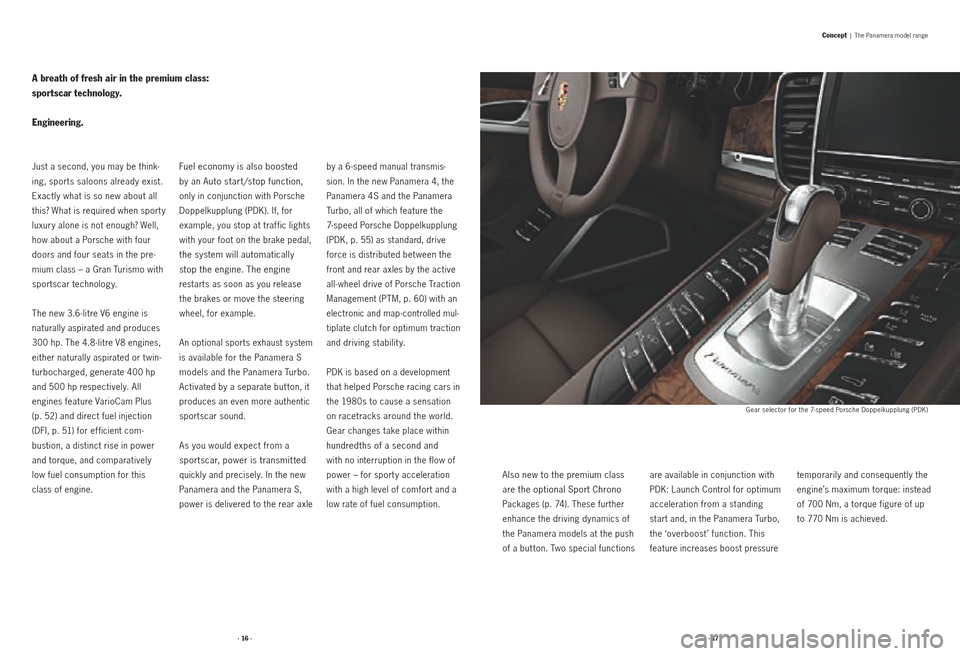
· 16 ·· 17 ·
Just a second, you may be think-
ing, sports saloons already exist.
Exactly what is so new about all
this? What is required when sport y
luxury alone is not enough? Well,
how about a Porsche with four
doors and four seats in the pre -
mium class – a Gran Turismo with
sportscar technology.
The new 3.6 -litre V6 engine is
naturally aspirated and produces
300 hp. The 4.8-litre V8 engines,
either naturally aspirated or t win-
turbocharged, generate 400 hp
and 500 hp respectively. All
engines feature VarioCam Plus
(p. 52) and direct fuel injection
(DFI, p. 51) for efficient com -
bustion, a distinct rise in power
and torque, and comparatively
low fuel consumption for this
class of engine.
A breath of fresh air in the premium class:
sportscar technology.
Engineering.
Fuel economy is also boosted
by an Auto start /stop function,
only in conjunction with Porsche
Doppelkupplung (PDK). If, for
example, you stop at traf fic lights
with your foot on the brake pedal,
the system will automatically
stop the engine. The engine
restarts as soon as you release
the brakes or move the steering
wheel, for example.
An optional sports exhaust system
is available for the Panamera S
models and the Panamera Turbo.
Activated by a separate but ton, it
produces an even more authentic
sportscar sound.
As you would expect from a
sportscar, power is transmit ted
quickly and precisely. In the new
Panamera and the Panamera S,
power is delivered to the rear axle by a 6-speed manual transmis
-
sion. In the new Panamera 4, the
Panamera 4S and the Panamera
Turbo, all of which feature the
7-speed Porsche Doppelkupplung
(PDK, p. 55) as standard, drive
force is distributed bet ween the
front and rear axles by the active
all-wheel drive of Porsche Traction
Management (PTM, p. 60) with an
electronic and map-controlled mul-
ti
plate clutch for optimum traction
and driving stability.
PDK is based on a development
that helped Porsche racing cars in
the 1980s to cause a sensation
on racetracks around the world.
Gear changes take place within
hundredths of a second and
with no interruption in the flow of
power – for sport y acceleration
with a high level of comfort and a
low rate of fuel consumption.
Also new to the premium class
are the optional Sport Chrono
Packages (p. 74). These further
enhance the driving dynamics of
the Panamera models at the push
of a but ton. Two special functions are available in conjunction with
PDK: Launch Control for optimum
acceleration from a standing
start and, in the Panamera Turbo,
the ‘overboost ’ function. This
feature increases boost pressure
Concept
| The Panamera model range
temporarily and consequently the
engine’s maximum torque: instead
of 700 Nm, a torque figure of up
to 770 Nm is achieved.
Gear selector for the 7-speed Porsche Doppelkupplung (PDK)
Page 18 of 80
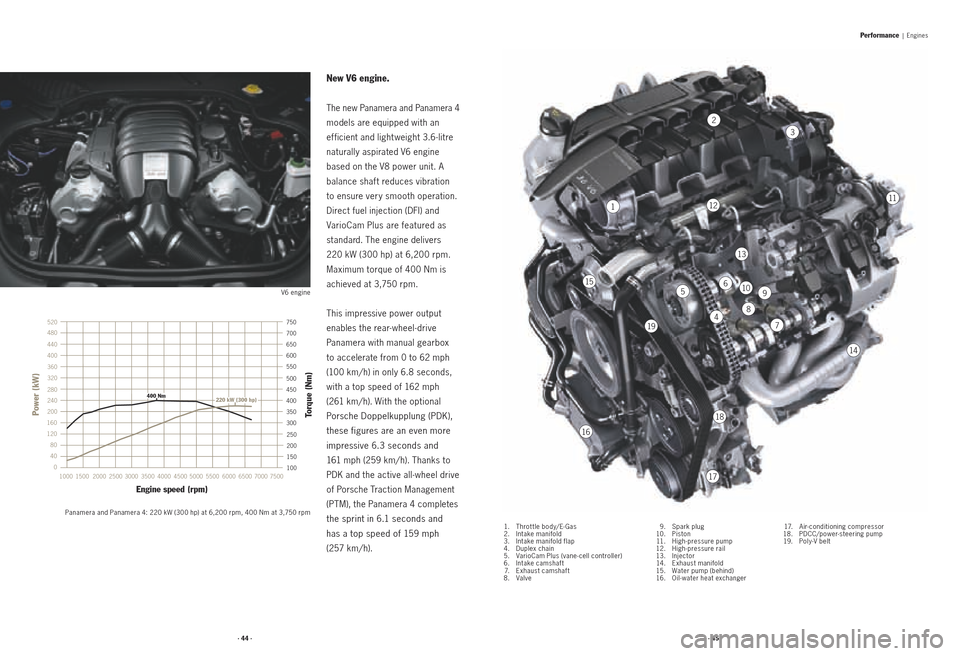
· 44 ·· 45 ·
2
3
11112
13
1561059
84197
14
18
16
17
Performance | Engines
V6 engine
Panamera and Panamera 4: 220 kW (300 hp) at 6,200 rpm, 400 Nm at 3,750 rpm
New V6 engine.
The new Panamera and Panamera 4
models are equipped with an
ef ficient and light weight 3.6 -litre
naturally aspirated V6 engine
based on the V8 power unit. A
balance shaft reduces vibration
to ensure very smooth operation.
Direct fuel injection (DFI) and
VarioCam Plus are featured as
standard. The engine delivers
220 kW (300 hp) at 6,200 rpm.
Maximum torque of 400 Nm is
achieved at 3,750 rpm.
This impressive power output
enables the rear-wheel- drive
Panamera with manual gearbox
to accelerate from 0 to 62 mph
(100 km/ h) in only 6.8 seconds,
with a top speed of 162 mph
(261 km/ h). With the optional
Porsche Doppelkupplung (PDK),
these figures are an even more
impressive 6.3 seconds and
161 mph (259 km/ h). Thanks to
PDK and the active all-wheel drive
of Porsche Traction Management
(PTM), the Panamera 4 completes
the sprint in 6.1 seconds and
has a top speed of 159 mph
(257 km/ h).
1. Throt tle body/ E- Gas
2. Intake manifold
3. Intake manifold flap
4. Duplex chain
5. VarioCam Plus (vane - cell controller)
6. Intake camshaf t
7. Exhaust camshaf t
8. Valve
9. Spark plug
10. P i s t o n
11. High - pressure pump
12. High - pressure rail
13. Injector
14. Exhaust manifold
15. Water pump (behind)
16. Oil -water heat exchanger
17. Air-conditioning compressor
18. PDCC/power-steering pump
19. Poly-V belt
100
300 350
400
450
500 550 600
650
160
120
1
80
140
100
200 240 280 320 360
400
4401500
7500
2000 2500 3000 3500 4000 4500 5000 5500 6000 6500 7000 150 200
2501000
480
700
520
750
400 Nm
200 205
210
215
220
225
230
235
240
245
250
255
260
265
270
275
280
285
290
295
300
40
60
80
100
120
140
160
180
200
220
240
260
280
300
320
340
360
380
400
420
440
500 1000 1500 2000 2500 3000 3500 4000 4500 5000 5500 6000 6500 7000
eff. red. Leistung [kW] eff. red. Drehmoment EWG [Nm]
Drehzahl [U/min]
Panamera V6 BDE 3,6l
Vollastkurve
Pemax. = 221 kW (300 PS) bei 6250 1/min
Md
max. = 400 Nm bei 4250 1/min
220 kW (300 hp)
Power (kW)
Engine speed (rpm)
Torque (Nm)
Page 20 of 80
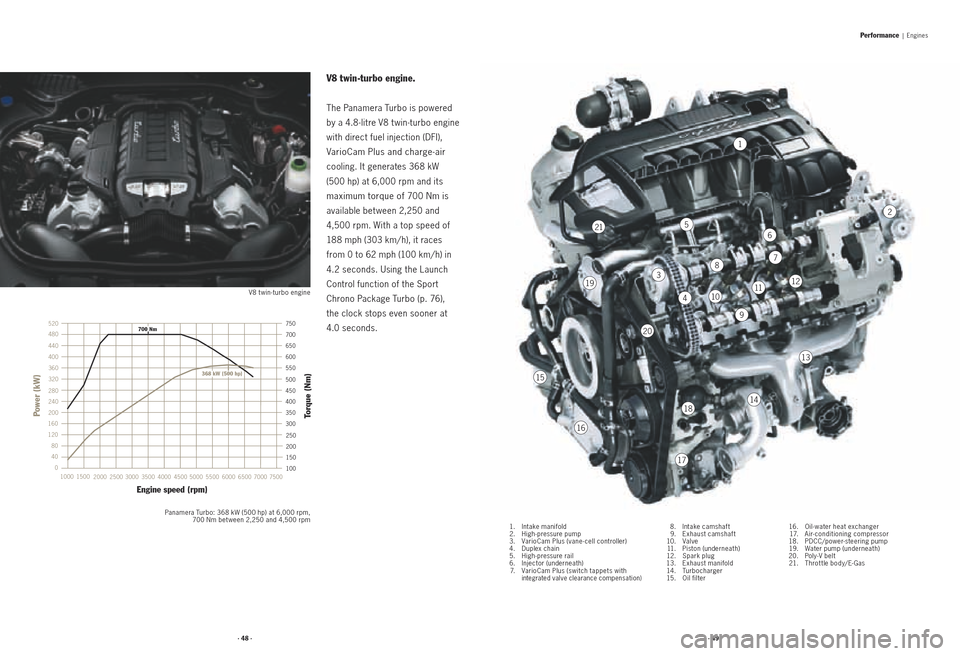
· 48 ·· 49 ·
1
2
3
4
56
78
9
101112
13
14
15
16
17
18
19
20
21
Performance | Engines
V8 twin-turbo engine.
The Panamera Turbo is powered
by a 4.8-litre V8 t win -turbo engine
with direct fuel injection (DFI),
VarioCam Plus and charge-air
cooling. It generates 368 kW
(500 hp) at 6,000 rpm and its
maximum torque of 700 Nm is
available bet ween 2,250 and
4,500 rpm. With a top speed of
188 mph (303 km/ h), it races
from 0 to 62 mph (100 km/ h) in
4.2 seconds. Using the Launch
Control function of the Sport
Chrono Package Turbo (p. 76),
the clock stops even sooner at
4.0 seconds.
V8 t win -turbo engine
Panamera Turbo: 368 kW (500 hp) at 6,000 rpm,
700 Nm bet ween 2,250 and 4,500 rpm 1. Intake manifold
2. High - pressure pump
3. VarioCam Plus (vane - cell controller)
4. Duplex chain
5. High - pressure rail
6. Injector (underneath)
7. VarioCam Plus (switch tappets with
integrated valve clearance compensation)
8. Intake camshaf t
9. Exhaust camshaf t
10. Valve
11. Piston (underneath)
12. Spark plug
13. Exhaust manifold
14. Turbocharger
15. Oil filter
16. Oil - water heat exchanger
17. Air-conditioning compressor
18. PDCC/power-steering pump
19. Water pump (underneath)
20. Poly-V belt
21. Throt tle body/ E- Gas
100
300 350
400
450
500 550 600
650
160
120
1
80
140
100
200 240 280 320 360
400
4401500
7500
2000 2500 3000 3500 4000 4500 5000 5500 6000 6500 7000 150 200
2501000
480
700
520
750
368 kW (500 hp)
700 Nm
Power (kW)
Engine speed (rpm)
Torque (Nm)
Page 21 of 80
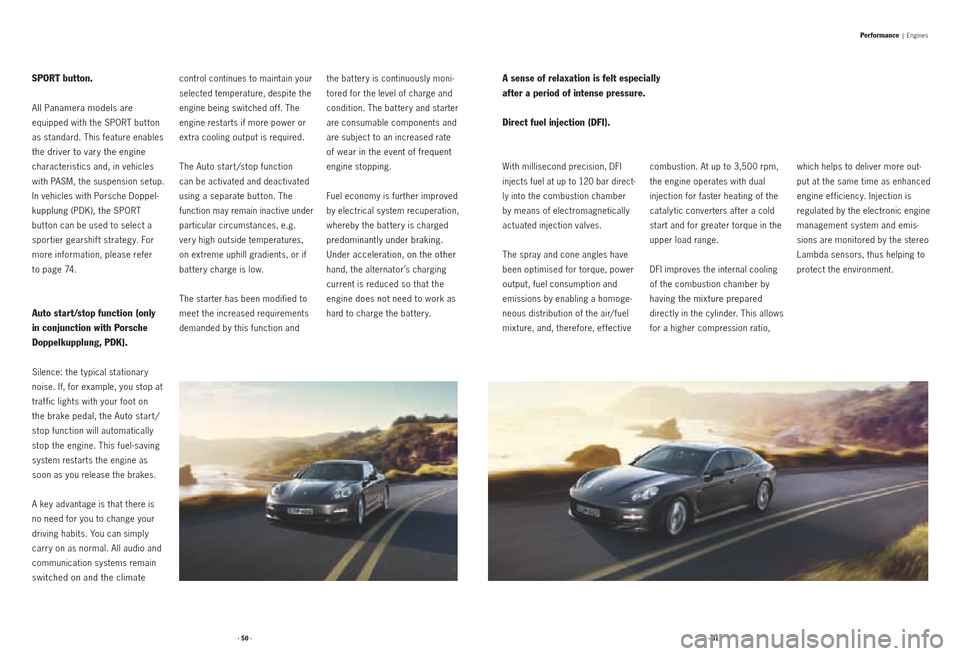
· 50 ·· 51 ·
SPORT button.
All Panamera models are
equipped with the SPORT but ton
as standard. This feature enables
the driver to vary the engine
characteristics and, in vehicles
with PASM, the suspension setup.
In vehicles with Porsche Doppel-
kupplung (PDK), the SPORT
but ton can be used to select a
sportier gearshif t strategy. For
more information, please refer
to page 74.
Auto start/stop function (only
in conjunction with Porsche
Doppelkupplung, PDK).
Silence: the t ypical stationary
noise. If, for example, you stop at
traf fic lights with your foot on
the brake pedal, the Auto start /
stop function will automatically
stop the engine. This fuel -saving
system restarts the engine as
soon as you release the brakes.
A key advantage is that there is
no need for you to change your
driving habits. You can simply
carry on as normal. All audio and
communication systems remain
switched on and the climate
control continues to maintain your
selected temperature, despite the
engine being switched of f. The
engine restarts if more power or
extra cooling output is required.
The Auto start /stop function
can be activated and deactivated
using a separate but ton. The
function may remain inactive under
particular circumstances, e.g.
very high outside temperatures,
on extreme uphill gradients, or if
bat tery charge is low.
The starter has been modified to
meet the increased requirements
demanded by this function and the bat tery is continuously moni
-
tored for the level of charge and
condition. The bat tery and starter
are consumable components and
are subject to an increased rate
of wear in the event of frequent
engine stopping.
Fuel economy is further improved
by electrical system recuperation,
whereby the bat tery is charged
predominantly under braking.
Under acceleration, on the other
hand, the alternator’s charging
current is reduced so that the
engine does not need to work as
hard to charge the bat tery.
Performance | Engines
With millisecond precision, DFI
injects fuel at up to 120 bar di rect -
l y
into the combustion chamber
by means of electromagnetically
actuated injection valves.
The spray and cone angles have
been optimised for torque, power
output, fuel consumption and
emissions by enabling a homoge -
neous distribution of the air/fuel
mixture, and, therefore, ef fective combustion. At up to 3,500 rpm,
the engine operates with dual
injection for faster heating of the
cataly tic converters af ter a cold
start and for greater torque in the
upper load range.
DFI improves the internal cooling
of the combustion chamber by
having the mixture prepared
direct
ly in the cylinder. This allows
for a higher compression ratio, which helps to deliver more out
-
put at the same time as enhanced
engine ef ficiency. Injection is
regulated by the electronic engine
management system and emis-
sions are monitored by the stereo
Lambda sensors, thus helping to
protect the environment.
A sense of relaxation is felt especially
after a period of intense pressure.
Direct fuel injection (DFI).
Page 22 of 80
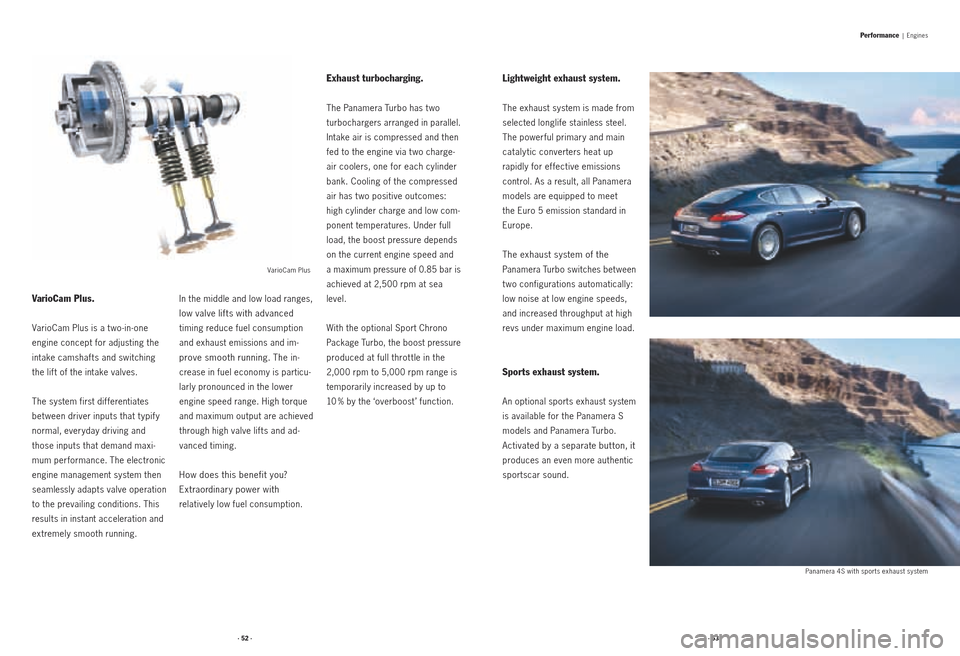
· 52 ·· 53 ·
Performance | Engines
VarioCam Plus.
VarioCam Plus is a t wo -in - one
engine concept for adjusting the
intake camshaf ts and switching
the lif t of the intake valves.
The system first dif ferentiates
bet ween driver inputs that t ypif y
normal, everyday driving and
those inputs that demand maxi -
mum performance. The electronic
engine management system then
seamlessly adapts valve operation
to the prevailing conditions. This
results in instant acceleration and
extremely smooth running. In the middle and low load ranges,
low valve lifts with advanced
timing reduce fuel consumption
and exhaust emissions and im -
prove smooth running. The i n -
crease in fuel economy is particu -
larly pronounced in the lower
engine speed range. High torque
and maximum output are achieved
through high valve lifts and ad -
vanced timing.
How does this benefit you?
Extraordinary power with
relatively low fuel consumption.
Exhaust turbocharging.
The Panamera Turbo has t wo
turbochargers arranged in parallel.
Intake air is compressed and then
fed to the engine via t wo charge-
air coolers, one for each cylinder
bank. Cooling of the compressed
air has t wo positive outcomes:
high cylinder charge and low com -
ponent temperatures. Under full
load, the boost pressure depends
on the current engine speed and
a maximum pressure of 0.85 bar is
achieved at 2,500 rpm at sea
level.
With the optional Sport Chrono
Package Turbo, the boost pressure
produced at full throt tle in the
2,000 rpm to 5,000 rpm range is
temporarily increased by up to
10 % by the ‘overboost ’ function.
VarioCam Plus
Lightweight exhaust system.
The exhaust system is made from
selected longlife stainless steel.
The powerful primary and main
cataly tic converters heat up
rapidly for ef fective emissions
control. As a result, all Panamera
models are equipped to meet
the Euro 5 emission standard in
Europe.
The exhaust system of the
Panamera Turbo switches bet ween
t wo configurations automatically:
low noise at low engine speeds,
and increased throughput at high
revs under maximum engine load.
Sports exhaust system.
An optional sports exhaust system
is available for the Panamera S
models and Panamera Turbo.
Acti
vated by a separate but ton, it
produces an even more authentic
sportscar sound.
Panamera 4S with sports exhaust system
Page 27 of 80
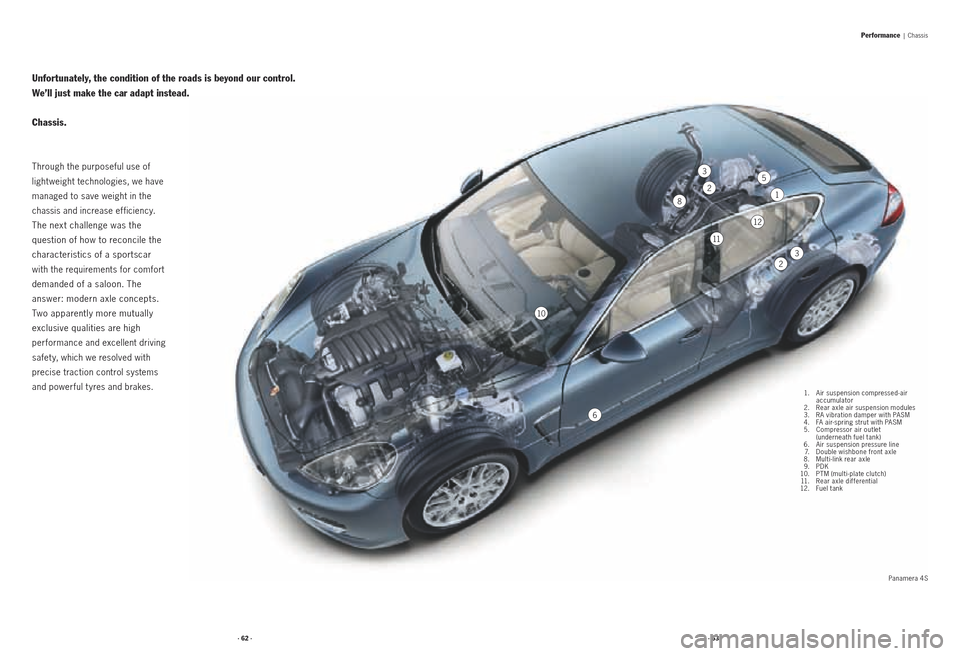
· 62 ·· 63 ·
4
7
9
4
6
10
1
23
5
8
11
2
3
12
Through the purposeful use of
light weight technologies, we have
managed to save weight in the
chassis and increase ef ficiency.
The next challenge was the
question of how to reconcile the
characteristics of a sportscar
with the requirements for comfort
demanded of a saloon. The
answer: modern axle concepts.
Two apparently more mutually
exclusive qualities are high
performance and excellent driving
safet y, which we resolved with
precise traction control systems
and powerful t yres and brakes.
Panamera 4S
Performance | Chassis
Unfortunately, the condition of the roads is beyond our control.
We’ll just make the car adapt instead.
Chassis.
1. Air suspension compressed -air
accumulator
2. Rear axle air suspension modules
3. RA vibration damper with PASM
4. FA air-spring strut with PASM
5. Compressor air outlet
(underneath fuel tank)
6. Air suspension pressure line
7. Double wishbone front axle
8. Multi - link rear axle
9. PDK
10. PTM (multi - plate clutch)
11. Rear axle dif ferential
12. Fuel tank
Page 28 of 80
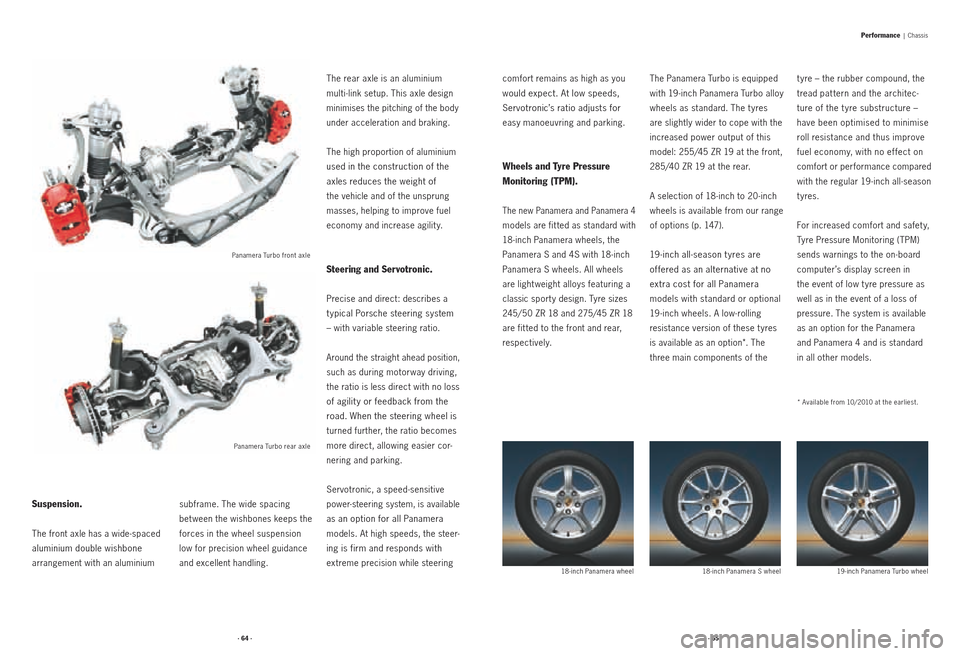
· 64 ·· 65 ·
Performance | Chassis
Suspension.
The front axle has a wide-spaced
aluminium double wishbone
arrangement with an aluminium subframe. The wide spacing
bet ween the wishbones keeps the
forces in the wheel suspension
low for precision wheel guidance
and excellent handling. The rear axle is an aluminium
multi-link setup. This axle design
minimises the pitching of the body
under acceleration and braking.
The high proportion of aluminium
used in the construction of the
axles reduces the weight of
the vehicle and of the unsprung
masses, helping to improve fuel
economy and increase agilit y.
Steering and Servotronic.
Precise and direct: describes a
t ypical Porsche steering system
–
with variable steering ratio.
Around the straight ahead position,
such as during motorway driving,
the ratio is less direct with no loss
of agilit y or feedback from the
road. When the steering wheel is
turned further, the ratio becomes
more direct, allowing easier cor -
nering and parking.
Servotronic, a speed-sensitive
power-steering system, is available
as an option for all Panamera
models. At high speeds, the steer -
ing is firm and responds with
extreme precision while steering comfort remains as high as you
would expect. At low speeds,
Servotronic’s ratio adjusts for
easy manoeuvring and parking.
Wheels and Tyre Pressure
Monitoring (TPM).
The new Panamera and Panamera 4
models are fit ted as standard with
18-inch Panamera wheels, the
Panamera S and 4S with 18-inch
Panamera S wheels. All wheels
are light weight alloys featuring a
classic sport y design. Tyre sizes
245/50 ZR 18 and 275/45 ZR 18
are fit ted to the front and rear,
respectively. The Panamera Turbo is equipped
with 19 -inch Panamera Turbo alloy
wheels as standard. The t yres
are slightly wider to cope with the
increased power output of this
model: 255/45 ZR 19 at the front,
285/40 ZR 19 at the rear.
A selection of 18-inch to 20 -inch
wheels is available from our range
of options (p. 147).
19-inch all-season t yres are
offered as an alternative at no
extra cost for all Panamera
models with standard or optional
19-inch wheels. A low-rolling
resistance version of these t yres
is available as an option*. The
three
main components of the
Panamera Turbo front axle
Panamera Turbo rear axle 19 - inch Panamera Turbo wheel
18 - inch Panamera S wheel
18 - inch Panamera wheel
t yre – the rubber compound, the
tread pat tern and the architec -
ture of the t yre substructure –
have been optimised to minimise
roll resistance and thus improve
fuel economy, with no ef fect on
comfort or performance compared
with the regular 19 -inch all-season
t yres.
For increased comfort and safet y,
Tyre Pressure Monitoring (TPM)
sends warnings to the on -board
computer’s display screen in
the event of low t yre pressure as
well as in the event of a loss of
pressure. The system is available
as an option for the Panamera
and Panamera 4 and is standard
in all other models.
* Available from 10/2010 at the earliest.
Page 78 of 80
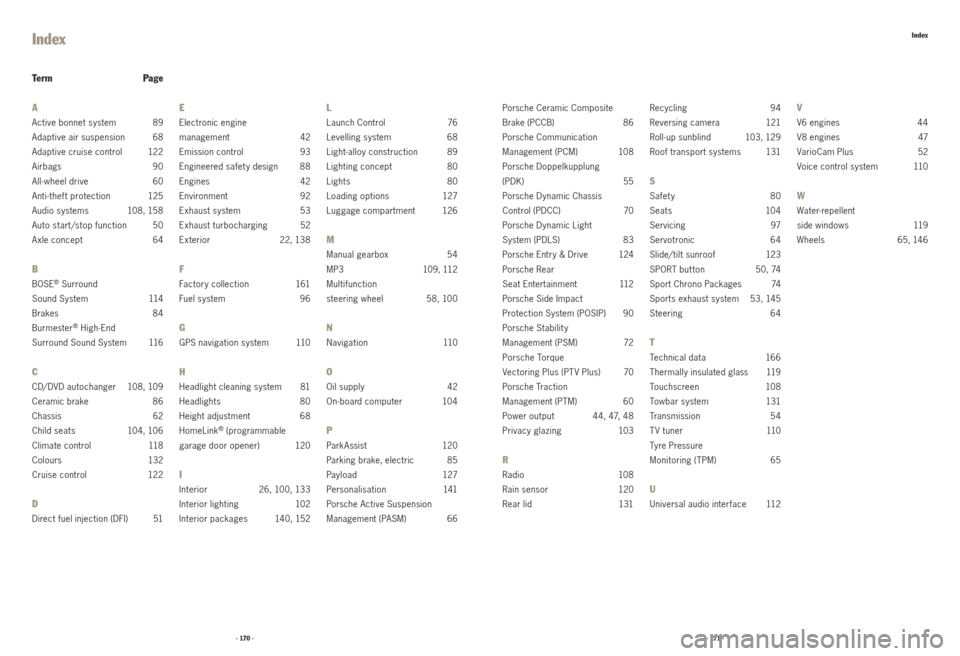
· 170 ·· 171 ·
Te r m Pa g e
A
Active bonnet system 89
Adaptive air suspension 68
Adaptive cruise control 122
Airbags 90
All-wheel drive 60
Anti-theft protection 125
Audio systems 108, 158
Auto start /stop function 50
A xle concept 64
B
BOSE® Surround
Sound System 114
Brakes 84
Burmester
® High - End
Surround Sound System 116
C
CD/ DVD autochanger 108, 109
Ceramic brake 86
Chassis 62
Child seats 104, 106
Climate control 118
C ol o u rs 132
Cruise control 122
D
Direct fuel injection (DFI) 51
E
Electronic engine
management 42
Emission control 93
Engineered safet y design 88
Engines 42
Environment 92
Exhaust system 53
Exhaust turbocharging 52
Exterior 22, 138
F
Factory collection 161
Fuel system 96
G
GPS navigation system 110
H
Headlight cleaning system 81
Headlights 80
Height adjustment 68
HomeLink
® (programmable
garage door opener) 120
I
Interior 26, 100, 133
Interior lighting 102
Interior packages 140, 152
L
Launch Control 76
Levelling system 68
Light-alloy construction 89
Lighting concept 80
Lights 80
Loading options 127
Luggage compartment 126
M
Manual gearbox 54
MP3 109, 112
Multifunction
steering wheel 58, 100
N
Navigation 110
O
Oil supply 42
On-board computer 104
P
Pa rk A ssist 120
Parking brake, electric 85
Pay l o a d 127
Personalisation 141
Porsche Active Suspension
Management (PASM) 66Porsche Ceramic Composite
Brake (PCCB)
86
Porsche Communication
Management (PCM) 108
Porsche Doppelkupplung
(PDK) 55
Porsche Dynamic Chassis
Control (PDCC) 70
Porsche Dynamic Light
System (PDLS) 83
Porsche Entry & Drive 124
Porsche Rear
Seat Entertainment 112
Porsche Side Impact
Protection System (POSIP) 90
Porsche Stabilit y
Management (PSM) 72
Porsche Torque
Vectoring Plus (PT V Plus) 70
Porsche Traction
Management (PTM) 60
Power output 44, 47, 48
Privacy glazing 103
R
Radio 108
Rain sensor 120
Rear lid 131Recycling
94
Reversing camera 121
Roll-up sunblind 103, 129
Roof transport systems 131
S
Safety 80
S e a t s 10 4
S e rv ici ng 97
Servotronic 64
Slide/tilt sunroof 123
SPORT but ton 50, 74
Sport Chrono Packages 74
Sports exhaust system 53, 145
Steering 64
T
Technical data 166
Thermally insulated glass 119
Touchscreen 108
Towbar system 131
Tra n s m i ssi o n 5 4
T V tuner 110
Tyre Pressure
Monitoring (TPM) 65
U
Universal audio interface 112
V
V6 engines 44
V8 engines 47
VarioCam Plus 52
Voice control system 110
W
Water-repellent
side windows 119
Wheels
6
5, 146
IndexIndex